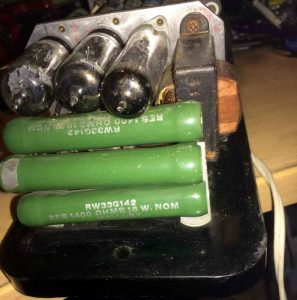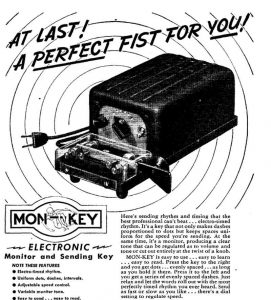
Thursday, Jan. 12, 2017, 3 p.m. — I won’t stay long, but just wanted to post a few lines in regard to a surprise eBay find … it was a surprise to me and apparently, my wife.

For a number of years I have collected a number of Mon-Key electronic keyers manufactured by the Electric Eye Equipment Co. of Danville, Ill. It was the first mass-marketed electronic keyer, and it made dots and dashes automatically … or it does if its working correctly.
The problem with the Mon-Keys you find these days is that the resistive line cords have opened, and the keyer won’t operate. As I’ve mentioned before, the resistive line cord was necessary because the tube filament voltages fell far short of adding up to anywhere near 110 volts AC. The line cord dissipated the rest of the voltage. The design works, but it also put AC on the key components.
Well, the latest addition of my group of Mon-Key keys includes a working example — and this one has had the resistive line cord replaced with a traditional zip cord power cord. The difference is a previous owner added three large power resistors whose goal is to replace the resistive element in the line cord with wire-wound resistance. The power resistors you see in the accompanying photo were added later, and on power up and in use, they work well.
The resistors DO get warm, but not excessively so.
The slowest speed on this one is slower than 8 wpm; the fastest speed is Warp Factor 6, I think … at its highest speed, the dahs sound like automatic weapon fire, and sending dits makes keying relay chatter in a way that reminds me of engine in my 1971 VW Type III fastback right before it seized up due to the lack of oil.

So far I’ve only tested the Mon-Key a couple of times for a 15 or 20 minutes per session. In that time the resistors were warm but not glowing red. The problem I need to look at is to check for dirt on the keying relay. One set of contacts on that relay control the sidetone, and the sidetone is a little intermittent. I’m fairly sure its the relay. Shouldn’t be a problem to clean up those contacts … as long as remember to remove the power before I remove the cover, HI!
73 es CUL de KY4Z … SK … dit dit …
